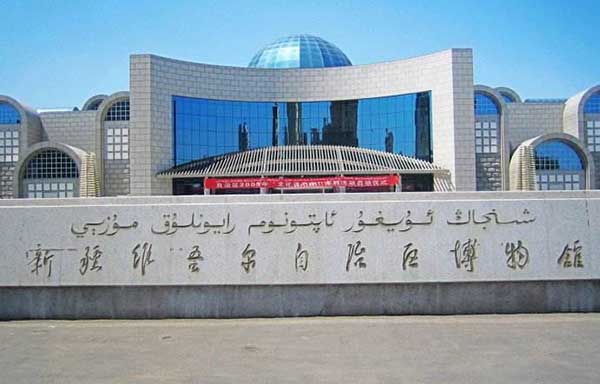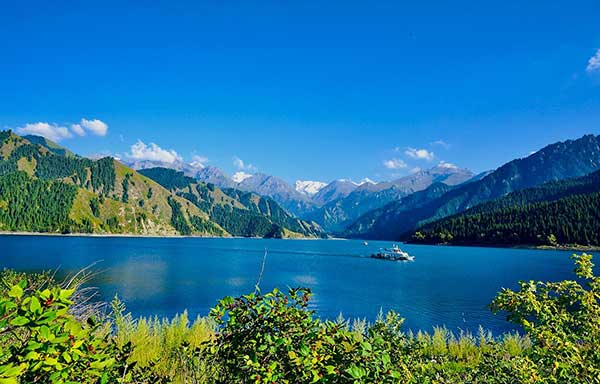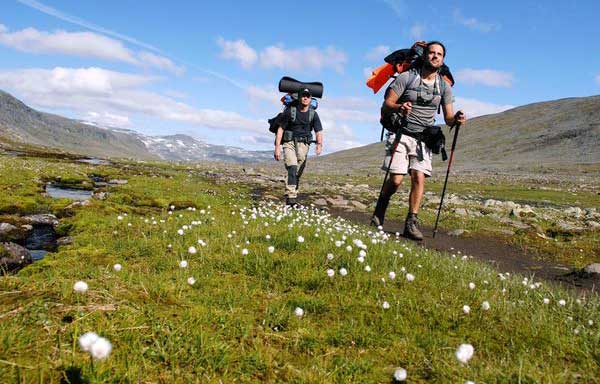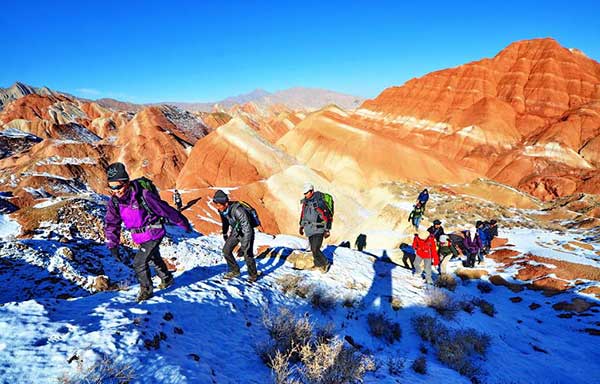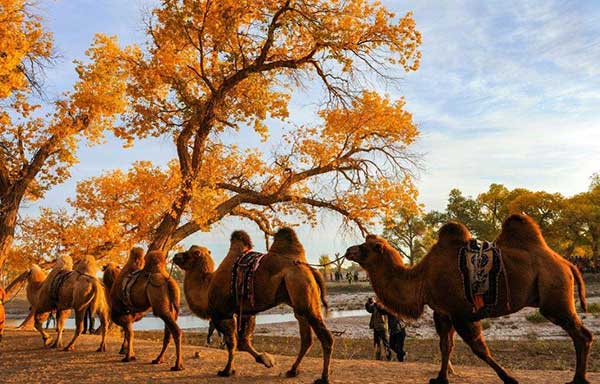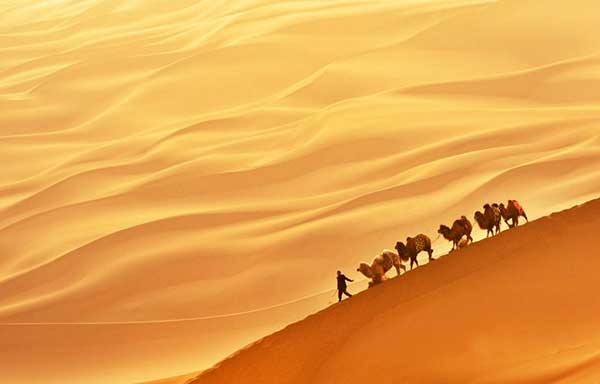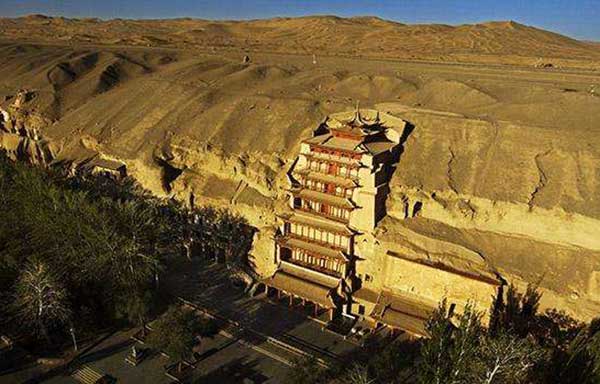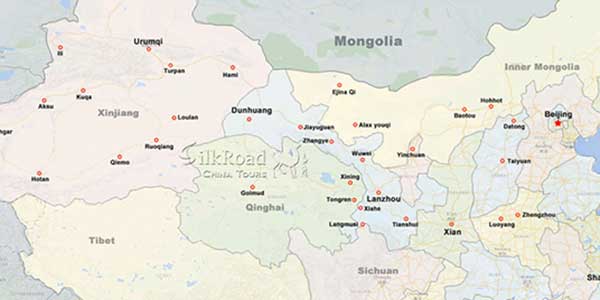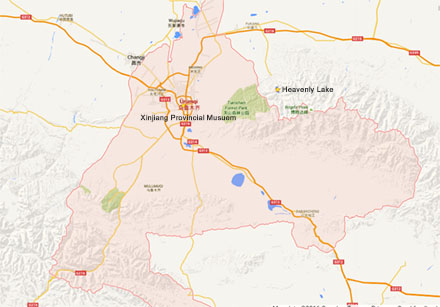 Urumqi, capital of Xinjiang Uyghur Autonomous Region, is the largest city in Western China and possibly the largest in Central Asia, with some excellent scenery in nearby Heavenly Lake and South Pasture. It also holds the record for the remotest major city in the world 2,500 km (1,400 mi) from the nearest sea.
Urumqi, capital of Xinjiang Uyghur Autonomous Region, is the largest city in Western China and possibly the largest in Central Asia, with some excellent scenery in nearby Heavenly Lake and South Pasture. It also holds the record for the remotest major city in the world 2,500 km (1,400 mi) from the nearest sea.
It is a booming modern industrial city of approaching 3 million, its spectacular growth fueled by mining and oil revenues. Although located on the Silk Road, it has only really emerged in the last 200 years. However, Xinjiang is rich in history, and the greatest collection of its artifacts can be found in XInjiang Museum.
The vast territory of Xinjiang (bigger than Alaska) is the eastern frontier of Central Asia, but only about 30 million people live in it. About a tenth of the people, about three million, live in Urumqi. Some of the best scenery, hiking, and ancient sites in China are in Xinjiang, and Urumqi is the ideal place to start a tour of the region. It has one of China’s big international airports and is Xinjiang's transportation hub.
Xinjiang has a tragic and interesting history, going through lots of changes of rule since the time of the Han Dynasty (206 BC - 220 AD). A Silk Road route went through the city. Xinjiang has large and very high mountain ranges, the Silk Road city of Kashgar which retains the atmosphere of its major trading post days, and arid Turpan, the lowest land in China, with its ancient ruins and irrigation system, and grape production.
Turpan is only about two hours from Urumqi. Turpan is a great travel site near an extremely arid and hot desert. Around Turpan you can see the vast Karez irrigation tunnels, the Flaming Mountains with the ruins of the ancient city of Gaochang and Jiaohe, big Buddhist grotto sites, lush grape farms, and some real Central Asian culture.
Urumqi is a base for touring the area, and the local highlights include the Uyghur Regional Museum with ancient Caucasian artifacts and mummies, the International Bazaar as an interesting place to shop, and the nearby Tianshan Mountains that have beautiful, forested mountains, lakes, and glaciers like the Alps.
If you can travel all over this great region, you can see ancient sites and natural beauty unlike the rest of China. The deserts are bigger, the basins are deeper, and the mountains are higher and emptier than anywhere except Tibet. The ancient remains left by Caucasian people are highly unusual. There has been a big mix of races, cultures and religions in the area, and all those tribes and empires left behind exotic remains. Since the region is so big and empty, hiking and camping there would offer a truly wild experience.
Urumqi itself is basically a Chinese city. About ten percent of the population are ethnic minority people, mostly Uyghur. The International Bazaar, also called the Big Bazaar (Da Baza 大巴扎 /dah bah-dzah/) or Erdaoqiao Market, is especially lively on summer evenings, and you can see a lot of local and regional products for sale. A lot of uniformed security guards and police are stationed around it. Next to the bazaar is Xinjiang Silk Road Museum at 160 Shengli Road. You can learn about the ancient Silk Road and about the region and its history. Bus 110 stops very close to it. The Urumqi Museum is located at 123 Nanhu South Road (南湖南路 123). The Xinjiang Uighur Regional Museum has Caucasian mummies that date from about 2,000 BC to 400 AD. They are thought be part of the biggest archeological discoveries of the past hundred years because they shed new light on the history of Eurasia.
About 150 km (93 miles) southeast of Urumqi, on the northern side of the Turpan Depression, is the small, mainly Uighur city of Turpan, which has about 300,000 inhabitants. It is a very lush irrigated area. Around the city of Turpan are the ruins of Jiaohe, the Flaming Mountains, named in the ancient Chinese fairytale "Journey to the West" (Xi You Ji 西游记 /sshee yoh jee/), the Astana Burial Grounds, and the Bezeklik Thousand Buddha caves, which are mostly in ruins. Water flows via underground viaducts that are thought of as one of the world’s biggest ancient construction projects. Before modern technology, they were what made the otherwise arid land of Turpan fertile and livable.
The natural scenery and hiking areas near Urumqi include Heavenly Lake (天池) that is east of Urumqi on Bogda Mountain at an elevation of about 2,000 meters or about 6,500 feet. The beautiful highland lake is flanked by rugged pines and cypresses and has clear water that reflects the surrounding mountains. You can hike and camp in the valley. For an extended hike, you can hike up Bogda Peak through forests and meadows. You can hike further up and see glaciers. For some softer hiking and lowland scenery, there is a grass covered mountain area called South Pasture about two hours south of Urumqi.
Weather

Attractions in Urumqi
Related Tours
General Information
Alias: Dihua
Area: 14,216 sq km
Location: Xinjiang
Airport: 18 km from the city
Train Station: 8 km from the city
Population: 3,530,000
Relevant blogs
-
How did the name of Tianshui in Gansu come about?
The name Tianshui is very pleasant to the ear, and it reminds one of that exquisitely beautiful verse, "After getting drunk, one doesn't know if the sky is in
-
The 8th Silk Road Hotel Festival was successfully
On December 27th, the "8th Silk Road Hotel Festival" grandly opened at the Yujing International Hotel in Zhangye. This hotel festival gathered industry experts,
-
The Karez Irrigation System in Turpan has been sel
On September 3rd, at the 75th Executive Council Meeting of the International Commission on Irrigation and Drainage held in Sydney, Australia, the 2024 (11th bat
-
What is the connection between "dragons" and "s
In traditional Chinese culture, the snake has a dual identity of auspiciousness and danger. Ancient people believed that the snake not only possesses divine cha
-
Endangered Przewalski's Horses Spotted at Dunhuan
<p>In early February, a group of special "visitors"—the Przewalski's horses—appeared at the Dunhuang Yumen Pass scenic area in Gansu Province, a U
-
The Fourth Dunhuang Cultural Tourism Supplier Conf
On the morning of February 18th, the Fourth Dunhuang Cultural Tourism Supplier Conference in Northwest China commenced at the Dunhuang International Convention

